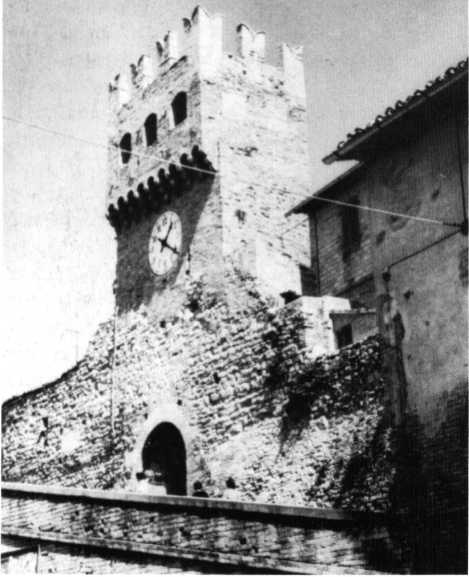56160 m136&
War against England but was now casting covetous eyes on Milan. The French controlled the smali County of Asti through a dynastie marriage which also gave France some claim to the Milanese Dukedom. Now there was also French occupation of Naples, a French alliance with Milan’s perpetual enemy Florence, and a pro-French Pope. When French garrisons were invited into the Republic of Genoa and a series of Florentine victories neutralized previously pro-Milanese States in northern Italy, Milan’s position was clearly threatened. Dal Verme also knew that a strategie plan had been prepared whereby Hawkwood’s Florentines would attack from the east while the French under the Count of Armagnac advanced from the west. In Milan’s favour were her unity of command, interior lines of communication across fiat countryside supplied with generally good roads, plus an excellent intelligence system. Invaders would almost in-evitably have to approach either across mountains or a series of rivers.
The I4th century Porta S. Agostino formed the lower gate of the tiny fortified town of Montefalco, near Perugia. Some-times called the Balcony of Umbria because of its altitude of nearly 500111., Montefalco was of vital strategie importance, first to the Lombard Duchy of Spoleto and later to the Papai States.
mmmmmm

In mid-May Hawkwood opened the campaign by Crossing the Adige, then the Mincio and other rivers flowing south from the Swiss Alps. But Dal Verme madę no move for, like Hawkwood, he expected a French army to appear from the west. The Florentines came within 50 kilometres of Milan until, with supply lines stretched and still no word ofthe French, Hawkwood felt he had won a morał victory and so began a steady withdrawal. Dal Verme now followed in a cautious pursuit while sending the Florentines courteous challenges to combat. The Milanese had reached Lodi and Hawkwood no longer posed a threat when news of the Count of Armagnac arrived. The French were descending on the strategically vital but well fortified Milanese frontier citadel of Alessandria. This faced the smali, hilly County of Asti, now a major French base, and the mountain passes south towards Genoa, while behind its protection lay the broad plains of Lombardy. A series of forced marches from Lodi enabled Dal Verme’s troops to catch the French completely by surprise beneath the walls of Alessandria. This time there were nonę ofthe courtesies previously seen between the two fellow-professionals, Dal Verme and Hawkwood. Instead, on 25 July, the Italians virtually annihilated the French army, slaying the Count of Armagnac and most of his leading knights. The surviving invaders fled back to the mountain passes, where so many were killed by local peasants that only a fragment of the French force got back to Provence.
S. Egideo (1416)
Two rival philosophies dominated the tactical concepts of the early 15th century in Italy: the Bracceschi, which supposedly emphasised the flexible use of smali detachments and encouraged initiative amongjunior leaders, and the Sforzeschi, which supposedly concentrated on the use of massed forces and the timing of all-out assaults. Nevertheless, the victory in which the father of one of these schools, Bracchio da Montone, finally won control over his own native city was most
An early i5th century fresco commemorating the Venetian defeat of the Emperor Barbarossa off Punta Salvore, over two hundred years earlier. This painting by Spinello Aretino in the Palazzo Pubblico, Siena, illustrates the career of Pope Alexander III, a native of the city; in the usual medieval manner it depicts war-gear of the artist’s own day.
26
Wyszukiwarka
Podobne podstrony:
107 distribution) was taken on consideration. The finał effect of the geobotanical regionalization o
A field trial using DWS with dual gas lift well was performed in a depleted oil field in the Coastal
.....The war againś# Gem any to the yićtorious ęnd is the tluty not only of our soldicr-., .iracr.
DSCF5542 My War Memories, 1914-1918 was indeed very serious, but, aft er all, the problem was not in
image002 •We re fighting a new kind of war against determined enemies. And public servants long into
m75# Professional infantry. The total strength of the bodyguard was normally about 5000 men, but&nbs
Some day, most drivers will enjoy car stereo of this sophistication. But for now, only Blaupunkt own
S5006939 (2) by way of the Madarovce culture. An argument against linking thc piąte with casting act
calibre cover (215) a :ł HV» •CUlOtM THE WAR AGAINST THE CHTORR • BOOK 2
Roger Zelazny Forever?ter (B) The War Against Evil Has Been Woni In this world the millennial batt
m750 Part of the painted Windows of St Denys, near Paris, now lost but preserved in the i8th-century
więcej podobnych podstron